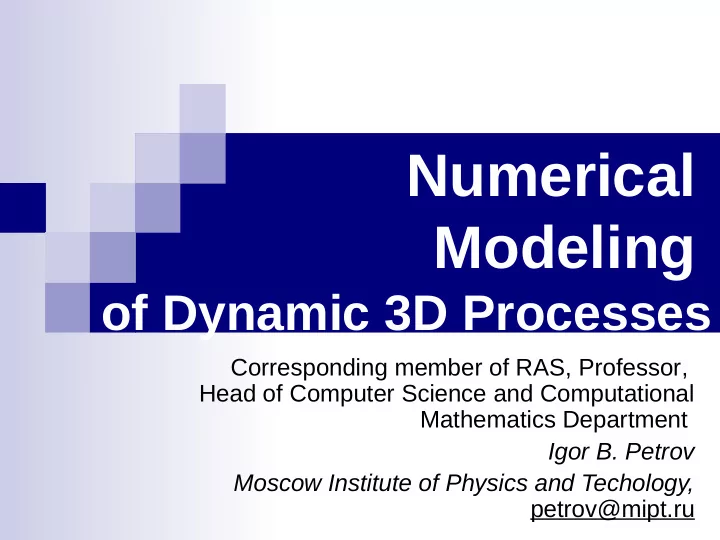

Numerical Modeling of Dynamic 3D Processes Corresponding member of RAS, Professor, Head of Computer Science and Computational Mathematics Department Igor B. Petrov Moscow Institute of Physics and Techology, petrov@mipt.ru
Contents Numerical modeling of Arctic problems Numerical simulation in geology The numerical solution of collision problems Numerical modeling of composite materials Numerical modeling in Medicine Numerical modeling of seismic stability Numerical modeling of non-destructive railway control Robot-technique Grid-characteristic method
Numerical modeling of Arctic problems
Migration of iceberg
Picture of Ship’s Damage R.E. Gagnon, J. Wang Numerical simulations of a tanker collision with a bergy bit incorporating hydrodynamics, a validated ice model and damage to the vessel // Cold regions. Science and Technology, 2012.
Collision between the ice-breaker and the ice-hummock
Impact of the ice hummock's keel on the seabed and on the underwater pipelines. M.A. Naumov, D.A. Onishchenko, Presentaion Gazprom VNIIGAZ LLC
Destruction of the iceberg under intense dynamic impacts
Destruction of the iceberg under intense dynamic impacts
The flow of ice floes towards the rack of fixed oil-extracting platform
Collision between the iceberg and the fjxed oil-extractjng platgorm 11
Structure of Ice-hummocks A. Marchenko Thermodynamic consolidation and melting of sea ice ridges // Cold regions. Science and Technology, V. 52, N. 3, 2008.
Ice-hummock model
Seismic exploration in the conditions of the Arctic shelf
Strimmer • 3D • P-waves • High performance
Seabed statjons • 3D/4C • High price • High comprehension of obtained data
Geophysical prospecting by electric means – seabed stations The leader of volume of work 6 components of the EM field (important for 3D inversion) Not smaller than 50 m EMGS, http://www.emgs.no
Geophysical prospecting by electric means - strimmers PGS, http://www.pgs.com/ • High performance • No deeper than 300 m • One axial component of the field: Ex • Frequency and time domain
Multilayered geological medium
Complicated interfaces
Complicated interfaces
Complicated interfaces
Seismic prospecting at the Arctic shelf
Wave pattern in the ice
Wave pattern in the water
Wave pattern in the ground
Wave pattern in the carbon reservoir
Problem defintions Source in the ice Source in the ice, without reservoir Source at the seabed Source at the seabed, without reservoir
Wave patterns
Seismograms from ice receivers, Vy Source in the ice Source in the ice, without reservoir Source at the seabed Source at the seabed, without reservoir
Seismograms from seabed receivers, Vy Source in the ice Source in the ice, without reservoir Source at the seabed Source at the seabed, without reservoir
Source at the bottom
Source at the bottom, without the reservoir
Numerical simulation in geology
Numerical simulation in geology
Cavities of various shape
The array of subvertical fluid filled cracks
The array of subvertical fluid filled cracks The distance between cracks/ the length of craks 0,5 1,0 1,5 2,0 3,0 4,0
Simple fluid filled cavity Reflected P-wave Reflected Wave from wave the source
The numerical solution of collision problems
Collision with multilayered barrier
Penetration of striker into curved barrier
Aircraft collision with the pillar
Multilayer barrier
Multilayer barrier
Numerical modeling of composite materials
Composite materials Microstructure Matrix and filler Types of fibers and their orientations 3D structure of fibers 9
The impact on the stringer 30
The destruction of steel body during ricochet impact
Numerical modeling in Medicine
Head damage Dependence from the angle = -90° Maximum compression, Maximum stretching, Maximum shear stress, 5 ·10 3 3 ·10 4 Па 3 ·10 4 Па Па
Comparison with clinical results
Knee injury
Body armour and human chest
Numerical modeling of seismic stability
Seismic stability of the building Absolute velocity (left) and destruction zones (right) in red
Seismic stability of river plant вода плотина земля
Seismic stability of the building
Love and Rayleigh waves Love waves Rayleigh waves
Numerical modeling of non-destructive railway control
Dynamic impact on the rail
The influence of karst inclusions in the ground above the railway
Non-destructive railway control Without crack 1 mm 5 mm 10 mm 40 mm 74 mm
Robot-technique
Robot-technique
Robot-technique
Robot-technique
Robot-technique
Robot-technique
Grid-characteristic method
Grids Triangular unstructured grid Grids with various average step
Grids Curvilinear grids Tetrahedral grids
System of equations describing elastic and acoustic waves v т ( ) t v σ ρ ∂ = ∇× Elastic waves: v v v ( ) т σ ( v ) I v ( v ) ∂ = λ ∇× + µ ∇ ⊗ + ∇ ⊗ t v v σ ρ density, velocity in the elastic media, stress tension, , λ µ Lame’s parameters, 1 2 ( ) ( ) c 2 = λ + µ ρ speed of P-waves, p 1 2 ( ) c = µ ρ speed of S-waves. s v t v p ρ ∂ = ∇ Acoustic waves: ∇× v 2 ( ) t pс v ∂ = ρ v v c p ρ density, velocity in the acoustic media, pressure, speed of sound.
Boundary and interface conditions Interface Boundary r Given traction Continuity of the velocity and traction r r r r r r σ p f = v v V σ , = = = − σ a b a b Free sliding conditions Given velocity of boundary r r r r r r v p v p , a b , a b 0 × = × σ = − σ σ = σ = v V = a b p p τ τ Mixed boundary conditions The interface condition between acoustic and elastic bodies Absorbing boundary contions
Thank you for your attention!
Recommend
More recommend